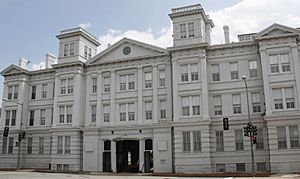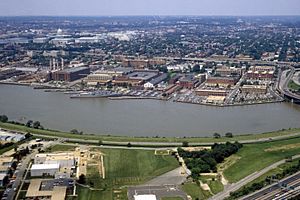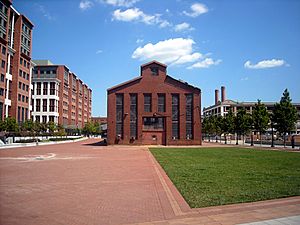Navy Yard, Washington, D.C. facts for kids

Navy Yard, also known as Near Southeast, is a cool neighborhood located along the Anacostia River in Southeast Washington, D.C.. It's bordered by Interstate 395 to the north, South Capitol Street to the west, and the Anacostia River to the south and east. The neighborhood gets its name from the famous Washington Navy Yard, which takes up about half of the area. Navy Yard is part of D.C.'s Ward 6. You can easily get there using the Navy Yard Metro station on the Green Line.
Contents
Long ago, the Anacostia River was a deep waterway. It had lots of natural resources and was home to the Nacotchtank Native American people. In 1791, Pierre Charles L'Enfant designed the plan for Washington D.C. He saw how important the Anacostia River was. So, he set up the city’s new business center and docks there.
In 1799, the Washington Navy Yard was built in the area. For many years, it was the biggest place in the nation for building naval ships. Today, the Washington Navy Yard has been run by the Navy longer than any other place.
A Busy Center in the 1800s
The Navy Yard was a very busy place in the 1800s. It was important for the growth of the area. The lively docks were a hub for jobs. They served ships bringing lumber and raw materials for the growing city. The Navy Yard also helped defend the city from the British during the War of 1812.
Around the docks, there was a large business area. There were also light industrial businesses and one of the city’s most well-known neighborhoods. As the city and nation grew, the Navy Yard changed. It stopped building ships and started making ship parts and weapons. By the mid-1940s, during wartime, the Navy Yard and its expanded Annex were making the most ammunition. They had 26,000 employees in 132 buildings.
Changes in the 1900s
However, during the 1900s, the Anacostia River became polluted. This made it less valuable to the city. After World War II, the Navy Yard moved its operations to a smaller area. This slowed down business in the neighborhood. Because of this and other reasons, the riverfront neighborhoods faced more challenges.
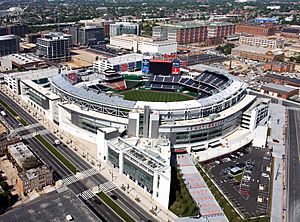
For many years, Navy Yard was mostly an industrial area. It also had a large commercial and entertainment district. But since 1990, the neighborhood has changed quickly. This was mainly due to the building of a new U.S. Department of Transportation office complex. Also, Nationals Park, the new stadium for the Washington Nationals baseball team, was built here.
Most of the land and businesses in the neighborhood have been bought by companies. They are now building new offices, shops, and homes.
Many new projects are changing the Navy Yard area. Here are some of the biggest ones:
- The Yards is a huge project covering 40 acres. It will have offices, homes, shops, and a 5.5-acre park along the river. The first homes were built in 2007. The whole project will be finished in phases over 10 to 20 years.
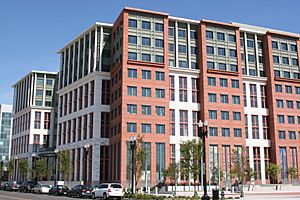
- In 2007, the United States Department of Transportation (USDoT) moved its headquarters to Navy Yard. Their new building is very large and houses 7,000 workers. Building 170, an old electrical substation from the Washington Navy Yard, is now owned by the USDoT.
- Nationals Park opened in 2008. This new baseball stadium can seat 41,000 fans. It's home to the Washington Nationals baseball team.
- The Ballpark District is the area around Nationals Park. It will have many shops, restaurants, offices, and homes. It will also have thousands of parking spaces.
- Capper/Carrollsburg is a project that will rebuild an older housing area. It will create new homes for people with different incomes. There will be both public housing and market-rate homes. It will also include office and retail spaces.
- The Capper Community Center is a new community building. It will have a daycare for children, a recreation center, a computer lab, a gym, a game room, and classrooms.
- New Marine barracks were built in the area in 2003. This provides housing and support for Marines.
- The 8th Street Historic District is an important part of Near Southeast. It has many old buildings and connects Capitol Hill to the Navy Yard. This area is also being redeveloped with new buildings.
- Maritime Plaza is a new development on East M Street. It includes office buildings. There are also plans for a hotel.
- Washington Canal Park is named after the historic Washington Canal. This canal once connected the Anacostia River to the Potomac River through the National Mall. The park will have trees, grass, plants, a splash pool, and a fountain. Water from nearby buildings will be cleaned and reused in the park's water features.
- Diamond Teague Park is a planned public plaza. It will be a main "window" between the new baseball stadium and the river. It is expected to be built in stages.
Images for kids


